Caryn’s Thoughts
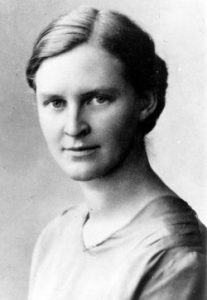 It was a big move for a Milwaukee, Wisconsin girl, but in the end, it would be her undoing. Mildred Fish was born in Milwaukee in 1902, and upon her high school graduation, she studied and then taught English at UW-Madison. It was there that she met Arvid Harnack, a Rockefeller Fellow from Germany. They soon fell in love, and were married in 1926. Because she was a progressive woman and proud of her name, Mildred chose to hyphenate her name, and became known as Mildred Fish-Harnack.
It was a big move for a Milwaukee, Wisconsin girl, but in the end, it would be her undoing. Mildred Fish was born in Milwaukee in 1902, and upon her high school graduation, she studied and then taught English at UW-Madison. It was there that she met Arvid Harnack, a Rockefeller Fellow from Germany. They soon fell in love, and were married in 1926. Because she was a progressive woman and proud of her name, Mildred chose to hyphenate her name, and became known as Mildred Fish-Harnack.
A few years later, she and Arvid both moved to Germany, where she taught and also worked on her doctorate while he worked for the German government. It was during those years that Fish-Harnack became interested in the Soviet Union, where women could choose where to work and also had other rights that women in the United States did not have…a situation which would very soon sound absurd. Nevertheless, at that time, it was so. Throughout the 1930s, Mildred and Arvid, who became increasingly 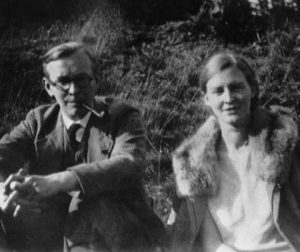 alarmed by Hitler’s rise to power, began to communicate with a close circle of associates who believed communism and the Soviet Union might be the only possible stumbling block to complete Nazi tyranny in Europe. As the Hitler and the Nazi regime began to come into power, Fish-Harnack and her husband joined a small resistance group, which the Nazi secret police…the Gestapo…would later call the Red Orchestra. This resistance group smuggled important secrets about the Nazis to the United States and Soviet governments and helped Jews escape from Germany. When war was declared in 1941, she did not leave with other American expatriates.
alarmed by Hitler’s rise to power, began to communicate with a close circle of associates who believed communism and the Soviet Union might be the only possible stumbling block to complete Nazi tyranny in Europe. As the Hitler and the Nazi regime began to come into power, Fish-Harnack and her husband joined a small resistance group, which the Nazi secret police…the Gestapo…would later call the Red Orchestra. This resistance group smuggled important secrets about the Nazis to the United States and Soviet governments and helped Jews escape from Germany. When war was declared in 1941, she did not leave with other American expatriates.
Of course, their activities were espionage and would eventually cost them their lives. For his part, her husband,  Arvid was hanged in December 1942. Mildred was given a six year sentence, but Hitler refused to endorse her punishment and she was retried and condemned on February 16, 1943. She was beheaded by guillotine. Because of her connection to possible communist sympathies and post-war McCarthyism, her story is virtually unknown in the United States. She was the only American woman who was ever put to death on the direct order of Adolf Hitler for her involvement in the resistance movement. Her last words were, “And I have loved Germany so much.” In the Cold War years after World War II, Fish-Harnack’s name and legacy were not honored in the United States, because she and her husband were believed to have been connected with Communism. For a time they were hated by both of their home countries. Once the truth came out in 1986, that changed and Mildred Fish-Harnack Day was established in Wisconsin. It takes place every year on her birthday, September 16th.
Arvid was hanged in December 1942. Mildred was given a six year sentence, but Hitler refused to endorse her punishment and she was retried and condemned on February 16, 1943. She was beheaded by guillotine. Because of her connection to possible communist sympathies and post-war McCarthyism, her story is virtually unknown in the United States. She was the only American woman who was ever put to death on the direct order of Adolf Hitler for her involvement in the resistance movement. Her last words were, “And I have loved Germany so much.” In the Cold War years after World War II, Fish-Harnack’s name and legacy were not honored in the United States, because she and her husband were believed to have been connected with Communism. For a time they were hated by both of their home countries. Once the truth came out in 1986, that changed and Mildred Fish-Harnack Day was established in Wisconsin. It takes place every year on her birthday, September 16th.
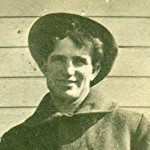
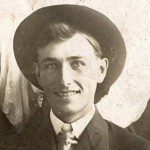 Animal skins were used for clothing and blankets for centuries. People didn’t have other options in ancient times. The fur trade continued into the Old West, and it’s history is filled with stories of adventure, daring, and savage warfare. It is said that being a trapper took a man of strong constitution. It wasn’t a job for sissies. The trappers suffered isolation in the wilderness, and battled constantly against wild beasts and wild men. Many trappers didn’t survive it, and in fact, the majority died in the silence of remote regions.
Animal skins were used for clothing and blankets for centuries. People didn’t have other options in ancient times. The fur trade continued into the Old West, and it’s history is filled with stories of adventure, daring, and savage warfare. It is said that being a trapper took a man of strong constitution. It wasn’t a job for sissies. The trappers suffered isolation in the wilderness, and battled constantly against wild beasts and wild men. Many trappers didn’t survive it, and in fact, the majority died in the silence of remote regions.
One of those men was my grandfather, Allen Luther Spencer. Grandpa, along with his brother-in-law, my Uncle Albert Schumacher decided to become trappers. Northern Minnesota was filled with animals that were perfect for trapping, and they had decided to make their fortune. It was a noble decision, but they really had no idea just how tough it would be. This was not a job for the casual trapper. Most trappings occurred in the great mountains. Here, the trappers spent the larger part of their lives. I don’t think my grandpa and my uncle really had any intention of living their lives in the isolated wilderness. They just wanted to make a living.
They trapped for a time, and really they didn’t do too bad, when it came to trapping, but I don’t think they were prepared for the cold and isolation. Northern Minnesota is one of the coldest places on earth. That would prove to be their undoing. Camping out in a tent in the winter in northern Minnesota…well, it was kind of crazy. I guess in that way, so were they. After a while, they realized just how crazy it was. While they had modest success at fur trapping, they decided that it wasn’t really worth it in the end. I can understand that. If it were just the cold, it might be one thing, but there were the wild animals too. Bears, mountain lions, wolves, just to name a few, while prime furs, are still a force to be contended with. When you pit man against beast, all too often, the beast comes out on top, Of the many trappers in the old west, many went out to trap, and never 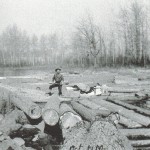
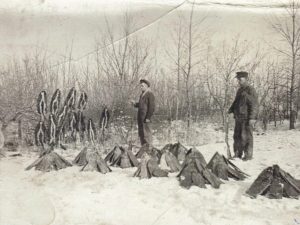 returned…not only never returned, but were never heard from again. I’m glad that was not the fate of my grandpa and my uncle.
returned…not only never returned, but were never heard from again. I’m glad that was not the fate of my grandpa and my uncle.
So, since they were already in the woods in northern Minnesota, and it was an area known for its lumber trade, they decided to abandon the fur trapping business, and go into the lumber business. That turned out to be a far better decision. Not only could they make a decent living, but they were able to sleep in a warm bed at night.
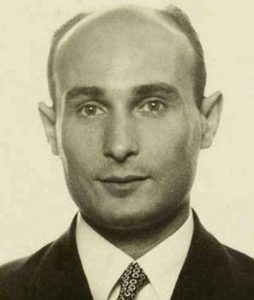 When someone sees something so horrific that the only think left to do is to act, drastic measures must be taken. Juan Pujol Garcia (aka Garbo), is one of the most successful intelligence agents in the annals of warfare. That is an amazing statement, but it is true. Garcia was a Spanish hotel manager who fiercely hated fascism and Germany. Garcia could see the horrific things that the Germans were doing, and he could not tolerate it. Garcia knew what he had to do, so he offered his services at the British embassy. Strangely, the British embassy staff laughed him out of the building, convincing the Spaniard the only way to impress the British was to infiltrate the German intelligence service, Abwehr.
When someone sees something so horrific that the only think left to do is to act, drastic measures must be taken. Juan Pujol Garcia (aka Garbo), is one of the most successful intelligence agents in the annals of warfare. That is an amazing statement, but it is true. Garcia was a Spanish hotel manager who fiercely hated fascism and Germany. Garcia could see the horrific things that the Germans were doing, and he could not tolerate it. Garcia knew what he had to do, so he offered his services at the British embassy. Strangely, the British embassy staff laughed him out of the building, convincing the Spaniard the only way to impress the British was to infiltrate the German intelligence service, Abwehr.
Without the help of the British government, Garcia decided that he had to take matters into his own hands. He headed to Lisbon, involved himself in the intrigue of the Portuguese capital, and was soon sending Abwehr a stream of bogus intelligence supposedly gleaned while traveling through Britain. In truth, he never left Lisbon, and was concocting information from films, newspapers, and even phone books. It was a drastic plan, but the stream of information earned him the trust of the Germans, and the British government finally gave Garcia 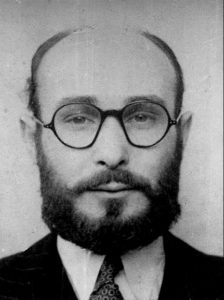 some missions. With this success to his credit, he talked his way into an interview in Britain with MI5. He was given the code name Garbo, after actress Greta Garbo, for his ability to spin convincing narratives out of thin air, and was put to work sending credible disinformation to the Germans.
some missions. With this success to his credit, he talked his way into an interview in Britain with MI5. He was given the code name Garbo, after actress Greta Garbo, for his ability to spin convincing narratives out of thin air, and was put to work sending credible disinformation to the Germans.
Now under cover, Garbo’s crowning achievement was his involvement in the operation to deceive the Nazis about the location of the Normandy invasion. He not only mislead the German high command about the location, but convinced them the D-Day landing was a diversion for an attack elsewhere. Garcia was such an important asset to the Nazis…or so they thought. The Germans even awarded him the Iron Cross, Second Class in July 1944. He also received the MBE from the British in November 1944. He had been a very successful double agent. After the war, Garbo deliberately faded into obscurity, fearing Nazi reprisals, and relocated to Venezuela, where he died in 1988.
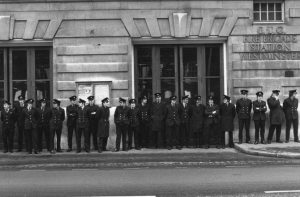 When we think of emergency personnel, we think of people who willingly put their lives on the line for others, and that is a good analogy, but while these people are passionate about their career, it is still a career. They expect, and need to be paid accordingly. Their job is dangerous, and they risk their lives every day, to go out and save other people. Unfortunately, they have to make a living too. For firefighters in England in 1977, the living they were making, wasn’t enough to support their families. So, as often happens, when the pay doesn’t equal the risk, the firefighters went on strike. They were demanding a 30% raise in pay.
When we think of emergency personnel, we think of people who willingly put their lives on the line for others, and that is a good analogy, but while these people are passionate about their career, it is still a career. They expect, and need to be paid accordingly. Their job is dangerous, and they risk their lives every day, to go out and save other people. Unfortunately, they have to make a living too. For firefighters in England in 1977, the living they were making, wasn’t enough to support their families. So, as often happens, when the pay doesn’t equal the risk, the firefighters went on strike. They were demanding a 30% raise in pay.
As the strike began, the 30,000 strong Fire Brigades Union claimed that 97.5% of its members had heeded the strike call and were no longer manning the pumps. It doesn’t take much imagination to realize that without firefighters, the cities were in serious trouble. Talks continued between union leaders and employers, but it didn’t look like there would be an early resolution, because the government insisted there was no breach of its 10% public sector pay ceiling.
As the situation became more critical, troops were brought in to provide emergency coverage of the cities. There was still concern among the soldiers about their lack of training and modern firefighting equipment. They would do their jobs, but that didn’t mean that they would know how to do it well. The reality is that firefighting is a highly skilled job, in which the people are trained, and they know the risks.
The firefighters said that they had already waited two years for the Government to consider their pay claim…and they were done waiting. During that two years, the police department had received a substantial pay rise while firefighters, in line with many others, had to settle for £6 per week. Much of the discussion between the union and employers is focused on the possibility of a reduction in the 48-hour working week, which would allow officers to earn considerable overtime payments.
In many areas firefighters have deserted their stations only reluctantly. Firemen, still wearing their uniforms and pickets armbands, rushed to the scene of a fire at St Andrew’s Hospital in Bow, East London, after a basement storeroom caught light. One of the officers said: “We couldn’t let them die.” And, “It was a hospital, what else could we do but come and help?” A colleague Barry Holmes said: “The situation here was really dangerous and people could have died if we had not come.” Emergency troops arrived at the scene first, and fire officers said afterwards that without their help the building would have burned to the ground.
“Elsewhere in the country, troops averted a major catastrophe on Merseyside when they stopped a haulage depot blaze at Kirkdale spreading to a 500 gallon gasoline storage tank. A woman and her twin sons escaped from a bungalow at Wallington in Surrey after a gas container exploded starting a fire. Troops in a Green Goddess had to drive 25 minutes from Croydon and the house was destroyed. The local fire station was less than three minutes drive away.” The striking firefighters received no strike pay, but got donations from the  public as Christmas approached. The insurance companies picked up the final bill for the dispute with payouts totaling £117.5m compared with £52.3m for the same three months the previous year. The firefighters eventually settled for a 10% increase, taking an average salary to just over £4,000, with the promise of more to come.
public as Christmas approached. The insurance companies picked up the final bill for the dispute with payouts totaling £117.5m compared with £52.3m for the same three months the previous year. The firefighters eventually settled for a 10% increase, taking an average salary to just over £4,000, with the promise of more to come.
Firefighters went on strike again in 2002/2003, in a long-running dispute which included a series of one day strikes over a period of several months. They finally ended with a 16% pay raise that was tied to a modernization package. The Fire Brigades Union chief, Andy Gilchrist said at the time of the settlement it was “a first phase” towards raising a fire officer’s basic pay to £30,000. I say, it was about time.
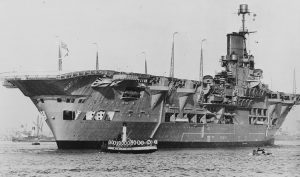
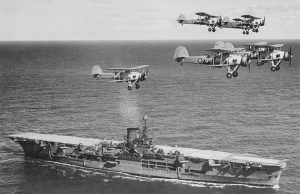 World War II brought with it necessary changes to war ships. Suddenly, the world had planes that could fly greater distances, and even had the ability to land on a ship, provided the ship was big enough to have a relatively short runway. I say relatively short, because the runways on ships seemed like they would be too short to safely land a plane, but they did. One such ship was the HMS Ark Royal.
World War II brought with it necessary changes to war ships. Suddenly, the world had planes that could fly greater distances, and even had the ability to land on a ship, provided the ship was big enough to have a relatively short runway. I say relatively short, because the runways on ships seemed like they would be too short to safely land a plane, but they did. One such ship was the HMS Ark Royal.
The Ark Royal was an English ship designed in 1934 to fit the restrictions of the Washington Naval Treaty. The ship was built by Cammell Laird at Birkenhead, England, and was completed in November 1938. The design of this ship differed from previous aircraft carriers, in that Ark Royal was the first ship on which the hangars and flight deck were an integral part of the hull, instead of an add-on or part of the superstructure. This ship was designed to carry a large number of aircraft. There were two hangar deck levels. HMS Ark Royal served during a period of time during which we first saw the extensive use of naval air power. The Ark Royal played an integral part in developing and refining several carrier tactics.
HNS Ark Royal served in some of the most active naval theatres of the World War II. The ship was involved in the first aerial and U-boat kills of the war, operations off Norway, the search for the German battleship Bismarck, and the Malta Convoys. After Ark Royal survived several near misses, she became known as a “lucky ship” and the reputation stuck…at least until November 13, 1941, when the German submarine U-81 torpedoed her and she sank the following day. Nevertheless, only one of her 1,488 crew members was killed. Her sinking was the subject of several inquiries. While only one man was killed, investigators still couldn’t figure out how the carrier was lost…in spite of efforts to tow her to the naval base at Gibraltar. In the end, they found that several design flaws contributed to the loss. These flaws were rectified in subsequent British carriers. There was, of course, no time to look for the ship then. The war was still going on.
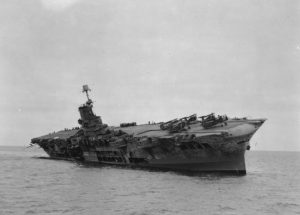
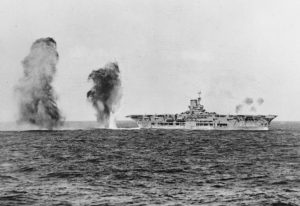
The wreck was discovered in December 2002 by an American underwater survey company using sonar mounted on an autonomous underwater vehicle. The company was under contract from the BBC for the filming of a documentary about the HMS Ark Royal. The ship was at a depth of about 3,300 feet and approximately 30 nautical miles from Gibraltar. So close, and yet so far away.
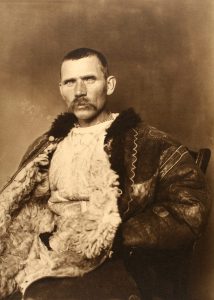
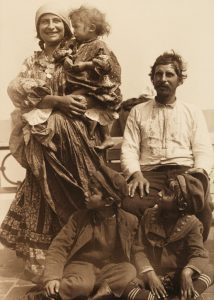
 The United States has long been known as “The Melting Pot,” in reference to the immigration of many of its citizens. The United States was not a country that began with all of its people in place. I suppose no nation was really. There is, however, a legal way to immigrate, and an illegal way to sneak into a country. For the purpose of this story, the melting pot refers only to legal immigration. Beginning in 1892, and continuing until 1924, Ellis Island, located in New York Harbor, was the entrance for immigrants entering the United States. Not everyone who entered the United States had to go through Ellis Island, however. First and Second Class passengers were not so required. They were allowed to do all of their immigration paperwork, and inspections onboard the ship that arrived on. The Third Class passengers, however, were required to go through Ellis Island. There, they had medical exams and legal inspections to determine if they were fit for entry into the United States.
The United States has long been known as “The Melting Pot,” in reference to the immigration of many of its citizens. The United States was not a country that began with all of its people in place. I suppose no nation was really. There is, however, a legal way to immigrate, and an illegal way to sneak into a country. For the purpose of this story, the melting pot refers only to legal immigration. Beginning in 1892, and continuing until 1924, Ellis Island, located in New York Harbor, was the entrance for immigrants entering the United States. Not everyone who entered the United States had to go through Ellis Island, however. First and Second Class passengers were not so required. They were allowed to do all of their immigration paperwork, and inspections onboard the ship that arrived on. The Third Class passengers, however, were required to go through Ellis Island. There, they had medical exams and legal inspections to determine if they were fit for entry into the United States.
It is estimated that 12 million immigrants came through Ellis Island in those years. In all, about 2% were denied entrance into the United States. Our nation was quite generous with its legal immigration requests. One 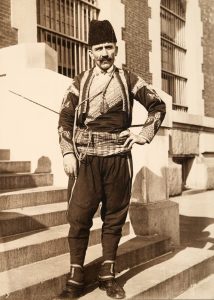
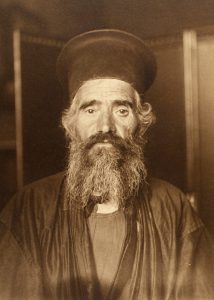 of the main reasons for the opening of Ellis Island was the change in the immigration requests. “Fewer arrivals were coming from northern and western Europe—Germany, Ireland, Britain and the Scandinavian countries—as more and more immigrants poured in from southern and eastern Europe. Among this new generation were Jews escaping from political and economic oppression in czarist Russia and eastern Europe (some 484,000 arrived in 1910 alone) and Italians escaping poverty in their country. There were also Poles, Hungarians, Czechs, Serbs, Slovaks and Greeks, along with non-Europeans from Syria, Turkey and Armenia. The reasons they left their homes in the Old World included war, drought, famine and religious persecution, and all had hopes for greater opportunity in the New World.”
of the main reasons for the opening of Ellis Island was the change in the immigration requests. “Fewer arrivals were coming from northern and western Europe—Germany, Ireland, Britain and the Scandinavian countries—as more and more immigrants poured in from southern and eastern Europe. Among this new generation were Jews escaping from political and economic oppression in czarist Russia and eastern Europe (some 484,000 arrived in 1910 alone) and Italians escaping poverty in their country. There were also Poles, Hungarians, Czechs, Serbs, Slovaks and Greeks, along with non-Europeans from Syria, Turkey and Armenia. The reasons they left their homes in the Old World included war, drought, famine and religious persecution, and all had hopes for greater opportunity in the New World.”
At one point, one of the men working on Ellis Island decided to bring his camera, and document the variety of people coming through. His photos really do show the “melting pot” that the United States was. He photographed a Romanian shepherd, a Serbian gypsy family, Danish captain, a bearded Greek priest, a Turkish bank guard, an Albanian soldier, an Algerian (wearing his finest clothes), and a tattooed German stowaway (who was eventually deported). It gives an inside look at the varied people who came to the United States, 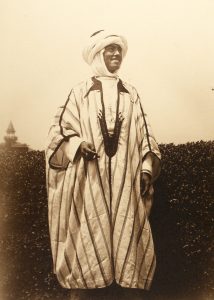
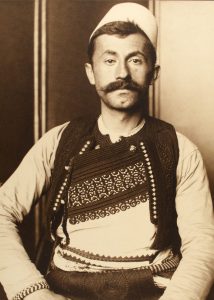
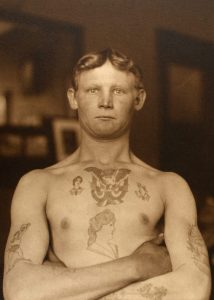 and these were just the third class passengers, seen on Ellis Island.
and these were just the third class passengers, seen on Ellis Island.
Ellis Island was used as an immigration center until 1924, at which time it was used until 1954 as a detention and deportation center for illegal immigrants. Now it is a museum, and a place where people can go to see if their ancestors came through on their way to a better life. The island had a varied past, and played a major role in creating “The Melting Pot” the United States was.
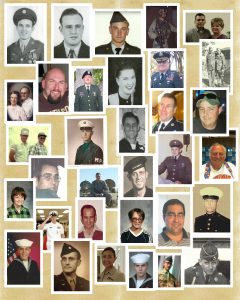 Unfortunately, we don’t live in a world without wars, so our soldiers are a vital part of our national security. Of course, we hope and pray that all of our soldiers will eventually come home from war, be discharged from military service, and become veterans. Sadly that is not always the case. For those who do not come home, we have Memorial Day, to honor their memory. Veteran’s Day, however, is a day to honor those who served, and then came home and went back to their lives. For those who are veterans, we take this opportunity to thank them for their service and their sacrifice, because they did sacrifice. They left their families at home, and went out to fight for people they don’t even know, and probably never will. We, here at home, have no way to really repay them for their acts of selflessness, so all we can do is thank them for their service. Somehow, it just doesn’t seem enough. How could we possibly repay them? We can never give them back the lost time with family, the memories, the births of children, and the multiple firsts that go with them. Those things are gone forever for the soldier, because they chose to go out and protect their country, and the people in it.
Unfortunately, we don’t live in a world without wars, so our soldiers are a vital part of our national security. Of course, we hope and pray that all of our soldiers will eventually come home from war, be discharged from military service, and become veterans. Sadly that is not always the case. For those who do not come home, we have Memorial Day, to honor their memory. Veteran’s Day, however, is a day to honor those who served, and then came home and went back to their lives. For those who are veterans, we take this opportunity to thank them for their service and their sacrifice, because they did sacrifice. They left their families at home, and went out to fight for people they don’t even know, and probably never will. We, here at home, have no way to really repay them for their acts of selflessness, so all we can do is thank them for their service. Somehow, it just doesn’t seem enough. How could we possibly repay them? We can never give them back the lost time with family, the memories, the births of children, and the multiple firsts that go with them. Those things are gone forever for the soldier, because they chose to go out and protect their country, and the people in it.
Our soldiers are an amazing group of people…the best in the world. They have blessed the people of this nation in so many ways. Their service goes beyond just fighting a war. They show kindness to the people in war ravaged countries, sometimes risking their own lives to do so. The biggest problems with civilians in war zones,  is that you never truly know if the people you meet need help, or if they are out to kill you. Nevertheless, our soldiers set aside the worries and fears, and go out to do their duty. That is what makes us proud. We wish it was unnecessary for them to go, but we are thankful when they do, because we know that we are safer.
is that you never truly know if the people you meet need help, or if they are out to kill you. Nevertheless, our soldiers set aside the worries and fears, and go out to do their duty. That is what makes us proud. We wish it was unnecessary for them to go, but we are thankful when they do, because we know that we are safer.
I wish all our soldiers could come home and that peace on earth could become a reality, but that is not to be. Nevertheless, to all our veterans, I thank you for your time in the service. We would not be where we ar today without you. Happy Veterans Day to all of you, from a grateful nation!!
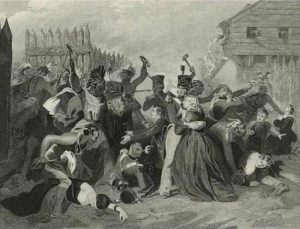 Most of us learned about Davy Crockett in school, but I don’t think that most of us really knew very much about him. Davy Crockett was an incredibly “macho” man. He was also an incredibly loyal man. During the War of 1812, the Creek Indian tribe split into factions. I suppose they thought to divide and conquer. One group, the Red Sticks, attacked Fort Mims on August 30, 1830, taking the lives of militiamen, civilians, and Creek allies. The Fort Mims massacre brought national outrage. Many men began to volunteer to fight the Creek Indians. Davy Crockett was among them. Crockett recalled, that he “had none of the dread of dying that I expected to feel,” but his wife, Mary “Polly” Finley did not share his optimism. She was terrified of losing her husband, and begged him not to go. Crockett felt obligated, and he did go. While he was off fighting, Polly became ill and passed away shortly after his return home. Crockett had 3 children with Polly…John Wesley, William, and Margaret.
Most of us learned about Davy Crockett in school, but I don’t think that most of us really knew very much about him. Davy Crockett was an incredibly “macho” man. He was also an incredibly loyal man. During the War of 1812, the Creek Indian tribe split into factions. I suppose they thought to divide and conquer. One group, the Red Sticks, attacked Fort Mims on August 30, 1830, taking the lives of militiamen, civilians, and Creek allies. The Fort Mims massacre brought national outrage. Many men began to volunteer to fight the Creek Indians. Davy Crockett was among them. Crockett recalled, that he “had none of the dread of dying that I expected to feel,” but his wife, Mary “Polly” Finley did not share his optimism. She was terrified of losing her husband, and begged him not to go. Crockett felt obligated, and he did go. While he was off fighting, Polly became ill and passed away shortly after his return home. Crockett had 3 children with Polly…John Wesley, William, and Margaret.
Losing Polly was very hard, but as often happened in those days, marriage after the loss of a wife came out of necessity. Davy needed someone to care for his children. He met a widow woman, Elizabeth Patton, who had children, and who lived nearby. Circumstances being what they were, Crockett began to visit the woman and after discovering his “company wasn’t at all disagreeable to her,” he decided he “could treat her children with so much friendship as to make her a good stepmother.” They married a short time later.
Crockett decided to move his family to Texas, but Elizabeth, while fine with that, asked that he go first to prepare things, and make sure he liked it there before they moved the family. It was probably a good thing in retrospect. Crockett arrived in East Texas in January 1836. He traveled through Nacogdoches and San Augustine before arriving in San Antonio. By the time he got there, the Texas Revolution was in full swing, and included thousands of Mexican troops led by Antonio López de Santa Anna. Their goal was to stop the Texas 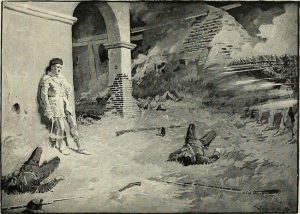 independence movement. The battle was fierce, and in the end, approximately 200 Texas militiamen were hunkered in at the Alamo when Santa Anna and his men arrived in February 1836. Crockett and the other men inside gathered supplies and did their best to prepare for the coming siege. Crockett was said to have helped with moral by making jokes and telling stories. The siege of the Alamo lasted 13 days, with the severely outnumbered Texans holding out until the walls of the compound were breached on March 6. As we all know, the men and women inside were all killed. Crockett was also killed, and that left Elizabeth widowed for a second time, but with more children this time. Still, by not taking the family, their lives were spared. Davy Crockett died at the age of 50 years.
independence movement. The battle was fierce, and in the end, approximately 200 Texas militiamen were hunkered in at the Alamo when Santa Anna and his men arrived in February 1836. Crockett and the other men inside gathered supplies and did their best to prepare for the coming siege. Crockett was said to have helped with moral by making jokes and telling stories. The siege of the Alamo lasted 13 days, with the severely outnumbered Texans holding out until the walls of the compound were breached on March 6. As we all know, the men and women inside were all killed. Crockett was also killed, and that left Elizabeth widowed for a second time, but with more children this time. Still, by not taking the family, their lives were spared. Davy Crockett died at the age of 50 years.
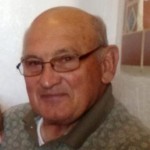
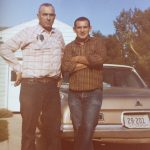 A number of years passed between the first time I met Uncle Butch Schulenberg, who is my father-in-law, Walt Schulenberg’s half-brother, and the reconnecting we had to him after my father-in-law’s passing. I consider those years a great loss, but I am thankful to have him back in our lives. There was no falling out or anything, just a lack of getting together, which is why I consider it such a great loss. It didn’t have to take that long. Uncle Butch is such a wonderful person, and I enjoy his company, and that of his lovely wife, Charlys very much.
A number of years passed between the first time I met Uncle Butch Schulenberg, who is my father-in-law, Walt Schulenberg’s half-brother, and the reconnecting we had to him after my father-in-law’s passing. I consider those years a great loss, but I am thankful to have him back in our lives. There was no falling out or anything, just a lack of getting together, which is why I consider it such a great loss. It didn’t have to take that long. Uncle Butch is such a wonderful person, and I enjoy his company, and that of his lovely wife, Charlys very much.
Butch is a great teller of stories, and I mean the kind I love to hear…family history. The best place to get those family history accounts, is from someone who lived them. Growing up the son of the local sheriff, I don’t know if Uncle Butch had to be good so his dad didn’t get after him for embarrassing him, or if he was one of those who got into a bit of trouble because he knew that his dad could get him out of it. I might have to guess that it 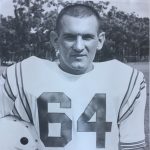 was a little bit of both, because I think that Uncle Butch has a mischievous side to him. I don’t think he was ever really bad, but as we all know, boys will be boys, so at least as a kid, my guess is that he tried to find out what his limits were.
was a little bit of both, because I think that Uncle Butch has a mischievous side to him. I don’t think he was ever really bad, but as we all know, boys will be boys, so at least as a kid, my guess is that he tried to find out what his limits were.
By the time he got into high school, Butch had discovered football, and that proved to be a great part of his school years. Lots of guys love to play, watch, eat, and sleep football, so to get to be part of the team is a cool thing. Uncle Butch was a good athlete, and was often talked about or written about in the local paper. He still loves all the local sports in Forsyth, Montana where he lived then, and still lives. He is probably one of their greatest boosters, and he knows the local talent personally, because it is a small town, so everyone knows everyone else. He is able to see their athletic growth, and knows the local teams’ stats. That’s what being a booster is all about. It’s one thing to cheer for a team, because they are the local kids, and another to know just how good the local kids are. The kids and the townspeople love Uncle Butch too, because he is a friendly guy who can always be counted on to lend a helping hand, or just to shoot the breeze. Uncle Butch is well liked, because he is so friendly.
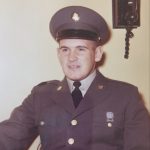
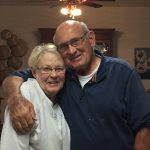
While Butch did live away from Forsyth for a short time, mostly while he was in the service, he has always been a local boy. He was born in Forsyth on November 9, 1940 to Andrew and Barbara (Fadhl) Schulenberg, and Forsyth would truly always be his home. Today is Uncle Butch’s 79th birthday. He doesn’t seem a day over 60 if you ask me. I think he’s a kid at heart and always will be. I will always treasure him. Happy 79th birthday Uncle Butch!! Have a great day!! We love you!!
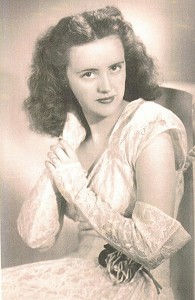
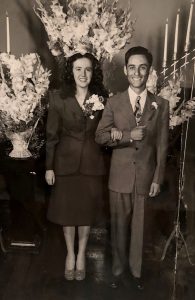 From the moment he first saw her, my future uncle, George Hushman, knew that Evelyn Byer was the girl for him. He was taken by her beauty, and he never had eyes for another…nor did she. Theirs was a match made in Heaven. They married on September 1, 1947, and they would go on to celebrate 67 years of marriage together. Her passing on May 4, 2015 was the saddest day of his life.
From the moment he first saw her, my future uncle, George Hushman, knew that Evelyn Byer was the girl for him. He was taken by her beauty, and he never had eyes for another…nor did she. Theirs was a match made in Heaven. They married on September 1, 1947, and they would go on to celebrate 67 years of marriage together. Her passing on May 4, 2015 was the saddest day of his life.
Aunt Evelyn and Uncle George decided to build a house for their family soon after their marriage. They, with the help of family members built the iconic house that stood next to the Mills Fire Station ever since. Everyone in town knew the beautiful house. Until Uncle George’s passing, they would be the only family ever to live there. That is a sad thought to me, but some things cannot be helped. A home is meant to be lived in, not held as a shrine to it’s builder.
Aunt Evelyn and Uncle George would be blessed with five beautiful children, Susie Young, George Hushman, Shelley Campbell, Shannon Limmer, and Gregory Hushman. They would also be blessed with grandchildren, 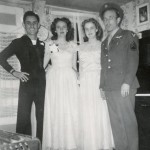 great grandchildren, and great great grandchildren, who are too numerous to name here. I have been blessed to be a niece to my aunt and uncle, as ar so many other nieces and nephews. Aunt Evelyn has always had a generous spirit, and many of us credit her with making our weddings perfect, by making the perfect wedding cake.
great grandchildren, and great great grandchildren, who are too numerous to name here. I have been blessed to be a niece to my aunt and uncle, as ar so many other nieces and nephews. Aunt Evelyn has always had a generous spirit, and many of us credit her with making our weddings perfect, by making the perfect wedding cake.
For years, Aunt Evelyn and Uncle George bowled as teammates to my parents, Allen and Collene Spencer (Evelyn and Collene being sisters). They had often double dated years ago, so bowling together was a logical next step. When the team decided they didn’t want to bowl any longer, Aunt Evelyn continued on by getting a team of some of her daughters together. I had the pleasure of being a substitute for them, whenever they needed one. We always had a great time. Those were really great days, and I miss them very much. We were 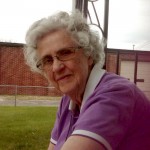
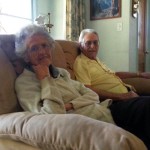 close, and enjoyed each other’s company. There was lots of laughter and fun, every week. Time goes by so quickly, and before we knew it, we were saying goodbye to Aunt Evelyn and then, Uncle George. As it was with my parents, aunts, and uncles before them, we find ourselves losing all the elders in our family, and I find that very sad, because they were in great respect the glue that held us all together. Today would have been Aunt Evelyn’s 91st birthday. Happy birthday in Heaven, Aunt Evelyn. We love and miss you very much.
close, and enjoyed each other’s company. There was lots of laughter and fun, every week. Time goes by so quickly, and before we knew it, we were saying goodbye to Aunt Evelyn and then, Uncle George. As it was with my parents, aunts, and uncles before them, we find ourselves losing all the elders in our family, and I find that very sad, because they were in great respect the glue that held us all together. Today would have been Aunt Evelyn’s 91st birthday. Happy birthday in Heaven, Aunt Evelyn. We love and miss you very much.

